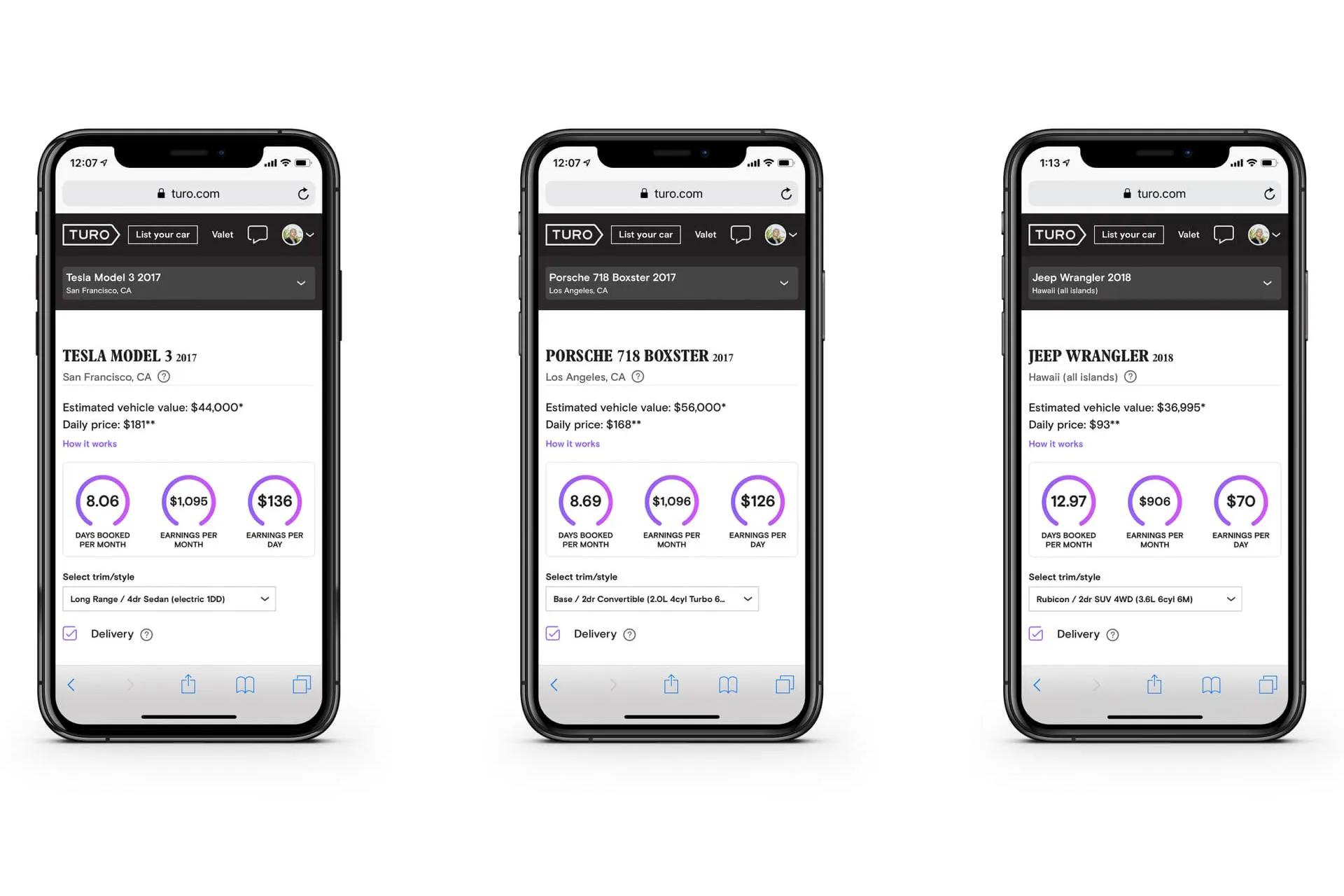
Carculator
Preface
The Carculator™ is a tool that allows people to estimate how much they might be able to earn by renting out their car on Turo. Using proprietary models trained on data collected over the years, the Carculator can estimate how often a car may be booked each month and how much it can expect to earn on a daily or monthly basis.
Credits
Role: Brand Designer Product Manager: Tom Wang Data Model: Toma Gulea Front-end: Lauren Kroner Back-end: Chris Eager, Victor Mora Copywriting: Steven Perez PR: Steve Webb
Meta
12/17/2018
In late 2018, Toma Gulea, a data scientist at Turo, had created a proof-of-concept earnings calculator that takes a car's make, model, year, and location and estimates how much it can earn on Turo based on that information. It was being used by people in other departments like sales and customer service to help prospective hosts get a glimpse of the economic opportunity that was sitting in their driveway.
A few stakeholders across different departments saw this as an opportunity to really legitimize the car sharing model and position Turo as "changing the economics of car ownership." One of Turo's core value propositions has always been this idea that our platform can turn a depreciating asset into an "earnings engine" (all credit for that alliteration goes to my copywriting partner in crime Steven Perez).
Discovery and definition
As a brand designer at the time, I worked closely with the marketing team on various free and paid traffic initiatives. The top-of-the-funnel was my area of focus — moving users from various channels to landing pages with the ultimate goal of signing up and listing or renting a car.
When the project was brought to me, we identified two goals:
- Evangelize car sharing — most people are understandably skeptical of the idea of letting strangers rent their car
- Generate free traffic and brand awareness — we wanted to create a useful tool that any car owner could use (and return to turo.com for)
At the time, other sharing economy platforms had earnings calculators on their landing pages. These examples tended to downplay and simplify their calculator's interfaces as their goal was to herd visitors toward conversion. We decided to take a different approach by breaking down other factors alongside projected earnings — we could estimate monthly utilization and optimal pricing against the vehicle's true market value. We wanted to do more than just dangle a pretty number in front of prospective hosts; we wanted to prove to the business-savvy user that sharing your car on Turo can have a real ROI.
By making it a standalone tool instead of tacking it onto an existing landing page, even our active hosts building out their small business could use it to inform their decision on what car to buy next.

Challenges
Although we had such lofty ideas for what this tool could be — we talked about Carculator even being its own app at some point — our deadline was tight and our resources were light. I faced a few big challenges in the roughly 2 weeks I had for design:
- Designing a visually compelling experience without relying on photos — we quickly discovered that those stock images of various car models you see online were expensive to license. Since Turo has a lot of vehicles on the platform, we would've needed a lot of images to cover each year of each model for each make.
- Packaging functional complexity into a simple and delightful experience — the team working on this was cherry-picked from other teams, so we couldn't let this take over our existing roadmap priorities for too long. We needed to be decisive; many features and interesting ideas had to be cut to keep scope narrow and focused.
- Location, location, location — similar to real estate, a car's location is a crucial factor in the calculation. We could confidently calculate estimates for about 25 market areas, so communicating that well while still allowing anyone outside those areas to find the tool useful was important for the experience.

Hosts, start your engines
Initially, we wanted to be able to show an image of the current car in the Carculator alongside its estimated car sharing performance, but doing so would have been incredibly costly. In the end, the value it would have added to the experience was questionable. Returning to the goal of the project and our fundamental value proposition of turning a car into an "earnings engine," we pivoted to a more graphical but still car-centric direction by presenting the Carculator's results as a gauge cluster.

Results
The Carculator came online on December 12, 2018. The next day, it was the 10th most visited page on the Turo domain. By January 10, about a month later, we had 46,000 sessions on the Carculator. While conversion wasn't our main goal, about 5% of web sessions that completed a listing since launch had visited the Carculator (~2,300 new listings).
Press
Turo's Carculator lets you see potential earnings from renting your ride (CNET)
Turo's new tool shows just how much your car can earn (Autoblog)
"Carculator" tells you how much money you can make renting out your car (Ars Technica)